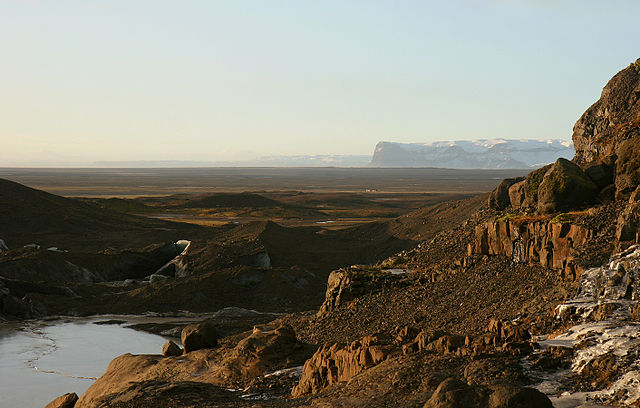A kettle is a depression or hole in an outwash plain formed by retreating glaciers or draining floodwaters. The kettles are formed as a result of blocks of dead ice left behind by retreating glaciers, which become surrounded by sediment deposited by meltwater streams as there is increased friction. The ice becomes buried in the sediment and when the ice melts, a depression is left called a kettle hole, creating a dimpled appearance on the outwash plain. Lakes often fill these kettles; these are called kettle hole lakes. Another source is the sudden drainage of an ice-dammed lake and when the block melts, the hole it leaves behind is a kettle. As the ice melts, ramparts can form around the edge of the kettle hole. The lakes that fill these holes are seldom more than 10 m (33 ft) deep and eventually fill with sediment. In acid conditions, a kettle bog may form but in alkaline conditions, it will be kettle peatland.

Satellite image of kettle lakes in Yamal Peninsula (Northern Siberia), adjacent to the Gulf of Ob (right). The lake colors indicate amounts of sediment or depth.
A kettle in the Isunngua highland, central-western Greenland
A kettle pond in the Hossa hiking area, Suomussalmi, Finland
Numerous kettle lakes border the Denali Highway in Alaska
An outwash plain, also called a sandur, sandr or sandar, is a plain formed of glaciofluvial deposits due to meltwater outwash at the terminus of a glacier. As it flows, the glacier grinds the underlying rock surface and carries the debris along. The meltwater at the snout of the glacier deposits its load of sediment over the outwash plain, with larger boulders being deposited near the terminal moraine, and smaller particles travelling further before being deposited. Sandurs are common in Iceland where geothermal activity accelerates the melting of ice flows and the deposition of sediment by meltwater.
Skeiðarársandur in Iceland, viewed from its eastern margin at the terminus of Svínafellsjökull glacier
The western edge of Skeiðarársandur in Iceland shows the diffuse drainage channels typical of sandur.
Unimpeded by topographic obstructions, sand-bearing katabatic winds can be fierce enough on Skeiðarársandur to strip paint from cars. Here, sand is blown in the air in front of the peak Lómagnúpur.







